The terrible storms and floods that devastated southern England in the winter of 2013-2014 were probably caused by climate change – more specifically, global warming which is the result of human activity, says a team of scientists from the UK, the Netherlands and France.
The succession of storms that hit southern England that winter caused at least 17 people to lose their lives, more than £451 million in insured losses, plus several hundreds of millions in uninsured losses.
In this study, which the scientists have written about in the prestigious journal Nature Climate Change, several large-scale climate model simulations were carried out.
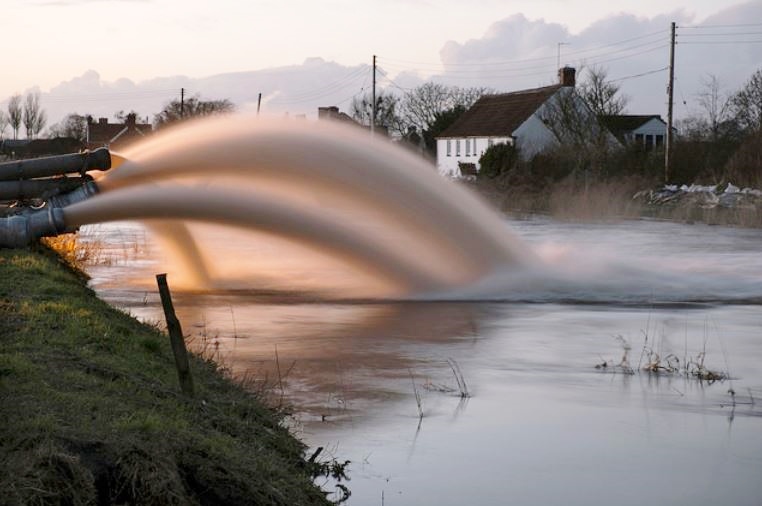 According to the Met Office, the 2013-2014 winter floods in southern England were responsible for the wettest December to January period since 1876. (Image: Wikipedia)
According to the Met Office, the 2013-2014 winter floods in southern England were responsible for the wettest December to January period since 1876. (Image: Wikipedia)
Anthropogenic activity raised flood risk
The simulations showed that as well as raising the amount of moisture that our atmosphere can hold, anthropogenic (originating in human activity) warming also caused a small but statistically significant increase in the number of 2014 January days with westerly flow – both these factors contributed to the extreme weather events (floods).
Lead author, Dr. Nathalie Schaller, of Oxford University’s Department of Physics, and colleagues found that anthropogenic greenhouse gas emissions significantly raised the likelihood of a once-a-century wet January in 2014 by forty-three percent (uncertainty range 0-160%).
The increase in extreme rainfall that brought about the flooding in the winter of 2013/2014 was mainly (two-thirds) caused by thermodynamic changes in the atmosphere, and partly (one-third) by dynamic changes. Thermodynamics is (physics) the science of the conversions between heat and other forms of energy. Dynamics is concerned with the effects of forces on the motion of things.
First-of-its-kind study
The worst-affected areas were the Thames Valley in the south east, and Cornwall, Dorset, Devon and Somerset in the south west.
The authors say theirs is the first-of-its-kind, end-to-end study that looked at the event all the way through – from beginning to end. It took in atmospheric circulation, river flow, rainfall, inundation, plus homes and other properties at risk.
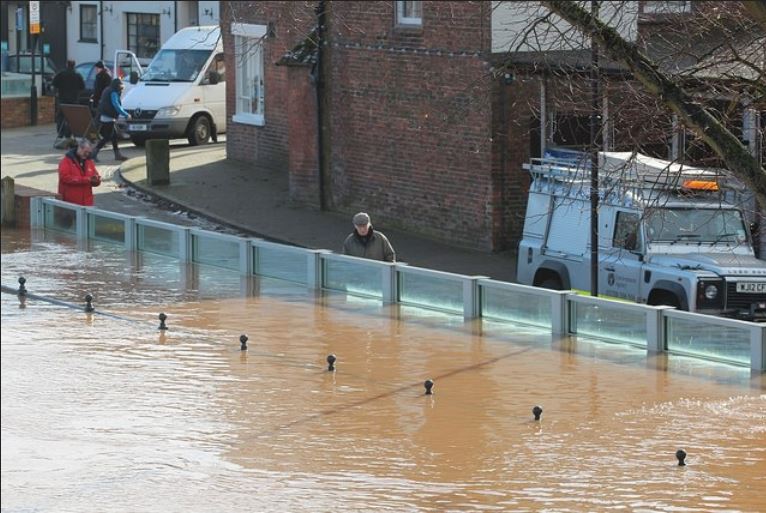 A man was anxiously looking at the rising waters at Upton-upon-Severn, hoping the flood protection would hold. It did! (Image: Wikipedia)
A man was anxiously looking at the rising waters at Upton-upon-Severn, hoping the flood protection would hold. It did! (Image: Wikipedia)
Dr. Schaller, a postdoctoral research assistant working on the European Commission Framework Programme 7 project EUCLEIA (EUropean CLimate and weather Events: Interpretation and Attribution), said regarding the January 2014 floods:
“We found that extreme rainfall, as seen in January 2014, is more likely to occur in a changing climate.”
“This is because not only does the higher water-holding capacity lead to increased rainfall, but climate change makes the atmosphere more favourable to low-pressure systems bringing rain from the Atlantic across southern England.”
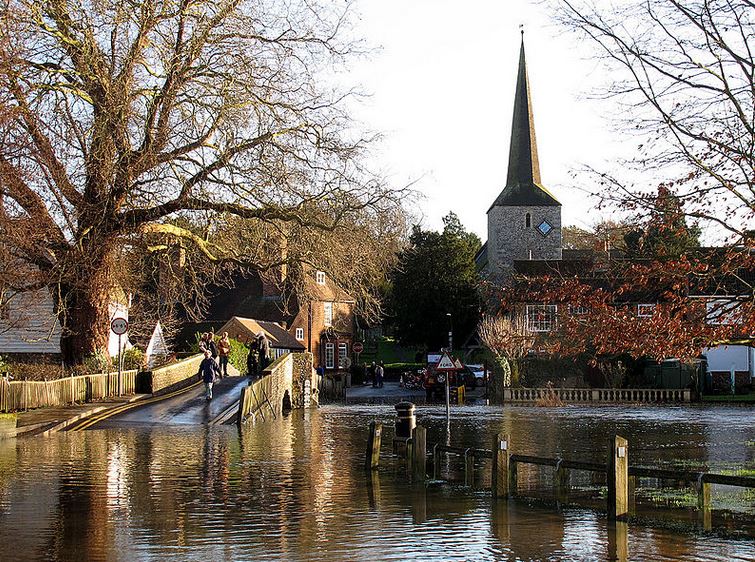 26 December 2013: Flooding on the River Darent, Eynsford, Kent. I was there a few weeks ago and was happy to see that it is a beautiful village again. (Image: Wikipedia)
26 December 2013: Flooding on the River Darent, Eynsford, Kent. I was there a few weeks ago and was happy to see that it is a beautiful village again. (Image: Wikipedia)
Comparing human-influenced and free-of-human-influence atmosphere
The team made use of the weather@home citizen-science project, part of the University of Oxford’s climateprediction.net climate model experiment, to model likely weather for January 2014 in both the current climate and one where humans had no influence on the atmosphere.
The scientists gathered and analyzed data on over one-hundred thousand simulations of possible rainfall in the United Kingdom run by citizens from across the globe.
Co-author Dr Pascal Yiou, who works at Le Laboratoire des Sciences du Climat et l’Environnement (LSCE) in Paris, said:
“The increase in extreme rainfall was due to a rise in moisture and very likely an increase in the frequency of deep depressions west of Scotland. The more extreme the weather, the stronger the effect of climate change over the UK.”
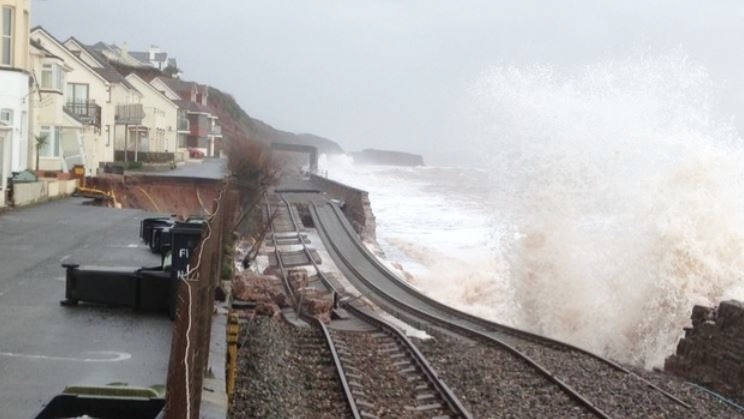 In Dawlish (Devon), the sea wall under the railway line collapsed, leaving the track suspended in mid-air. In its report on the 2014 winter storms, the Met Office wrote: “There is also an increasing body of evidence that shows that extreme daily rainfall rates are becoming more intense, and that the rate of increase is consistent with what is expected from the fundamental physics of a warming world.” (Image:metoffice.gov.uk)
In Dawlish (Devon), the sea wall under the railway line collapsed, leaving the track suspended in mid-air. In its report on the 2014 winter storms, the Met Office wrote: “There is also an increasing body of evidence that shows that extreme daily rainfall rates are becoming more intense, and that the rate of increase is consistent with what is expected from the fundamental physics of a warming world.” (Image:metoffice.gov.uk)
Increase in river-related flooding risk
In addition, hydrological modelling (water cycle modelling) of the Thames river catchment showed that changes in atmospheric circulation and precipitation caused greater peak 30-day river flow, while flood-risk mapping showed a slight increase in flood risk for properties within the Thames catchment area.
Co-author, Dr. Friederike Otto, a senior researcher at Oxford University’s ECI Global Climate Science Programme, who also leads and coordinates the distributed computing climate modelling project climateprediction.net., said regarding this study:
“For the first time ever, this study doesn’t stop at rainfall and river flow but attributes the change in risk from the meteorology down to the direct impact of flooded houses in the river catchment zones.”
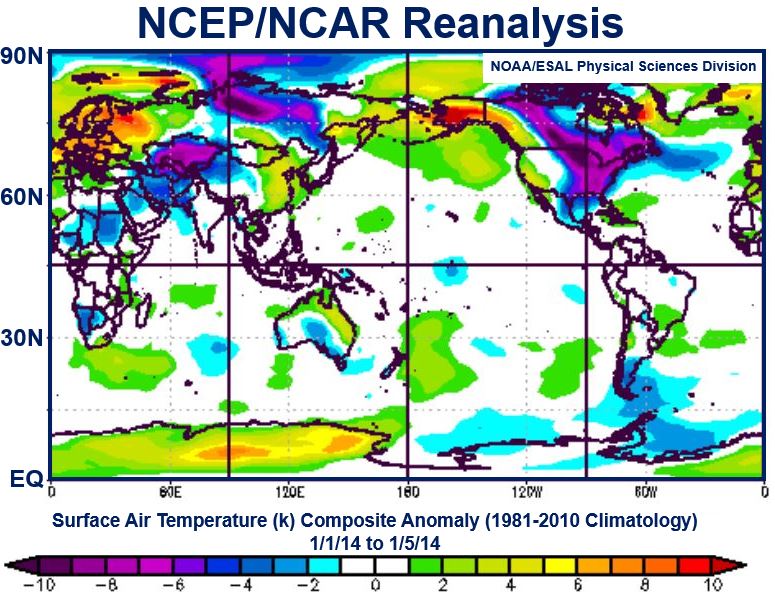 Surface air temperature anomalies (°C) for the first week of January 2014 compared to the long-term climatology for 1981-2010. The exceptional weather experienced over the UK in December and January was part of a hemispheric pattern of severe weather. This included exceptionally low temperatures across Canada and the USA from the mid-west to the eastern seaboard and reaching as far south as Texas. (Source: Met Office)
Surface air temperature anomalies (°C) for the first week of January 2014 compared to the long-term climatology for 1981-2010. The exceptional weather experienced over the UK in December and January was part of a hemispheric pattern of severe weather. This included exceptionally low temperatures across Canada and the USA from the mid-west to the eastern seaboard and reaching as far south as Texas. (Source: Met Office)
Co-author Dr Alison Kay, a a senior mathematical modeller from the Centre for Ecology & Hydrology, part of the Natural Environment Research Council, said regarding their hydrological modelling:
“Our hydrological modelling suggests that the increased likelihood of extreme rainfall arising from man-made climate change gives a more modest increase in extreme flows in the River Thames.”
“This highlights the importance of applying hydrological models in order to include the role of the landscape in transforming rainfall into river flows and floods.”
The increased risk of rainfall found in the meteorological modelling led to a rise in the peak thirty-day river flow of 21% and about 1,000 more properties at risk of flooding.
Professor Rob Lamb, who works at the Department: Mathematics and Statistics, Lancaster Environment Centre, Lancaster University, and is also chief scientist at The JBA Trust, said regarding flood risk and greenhouse gas emissions:
“Each of these steps reflects different sources of uncertainty, but we find overall that there is a substantial chance of more properties having been placed at flood risk because of past greenhouse gas emissions, leading to potential damages that could be part of the losses incurred in 2013/14.”
Citation: “Human influence on climate in the 2014 southern England winter floods and their impacts,” Antje Weisheimer, Simon Wilson, Nathalie Schaller, Alison L. Kay, Rob Lamb, Peter A. Stott, Jessica Skeggs, David Wallom, Neil R. Massey, Geert Jan van Oldenborgh, Tim Legg, Jonathan Miller, Friederike E. L. Otto, Sarah N. Sparrow, Robert Vautard, William J. Ingram, Richard G. Jones, Pascal Yiou, Andy Bowery, Ian Ashpole, Susan M. Crooks, Karsten Haustein, Chris Huntingford & Myles R. Allen. Nature Climate Change. 1 February, 2016. DOI: 10.1038/nclimate2927.
Video – Floods in souther England: Winter 2014
This was a BBC News report, broadcast on 6th February, 2014.

